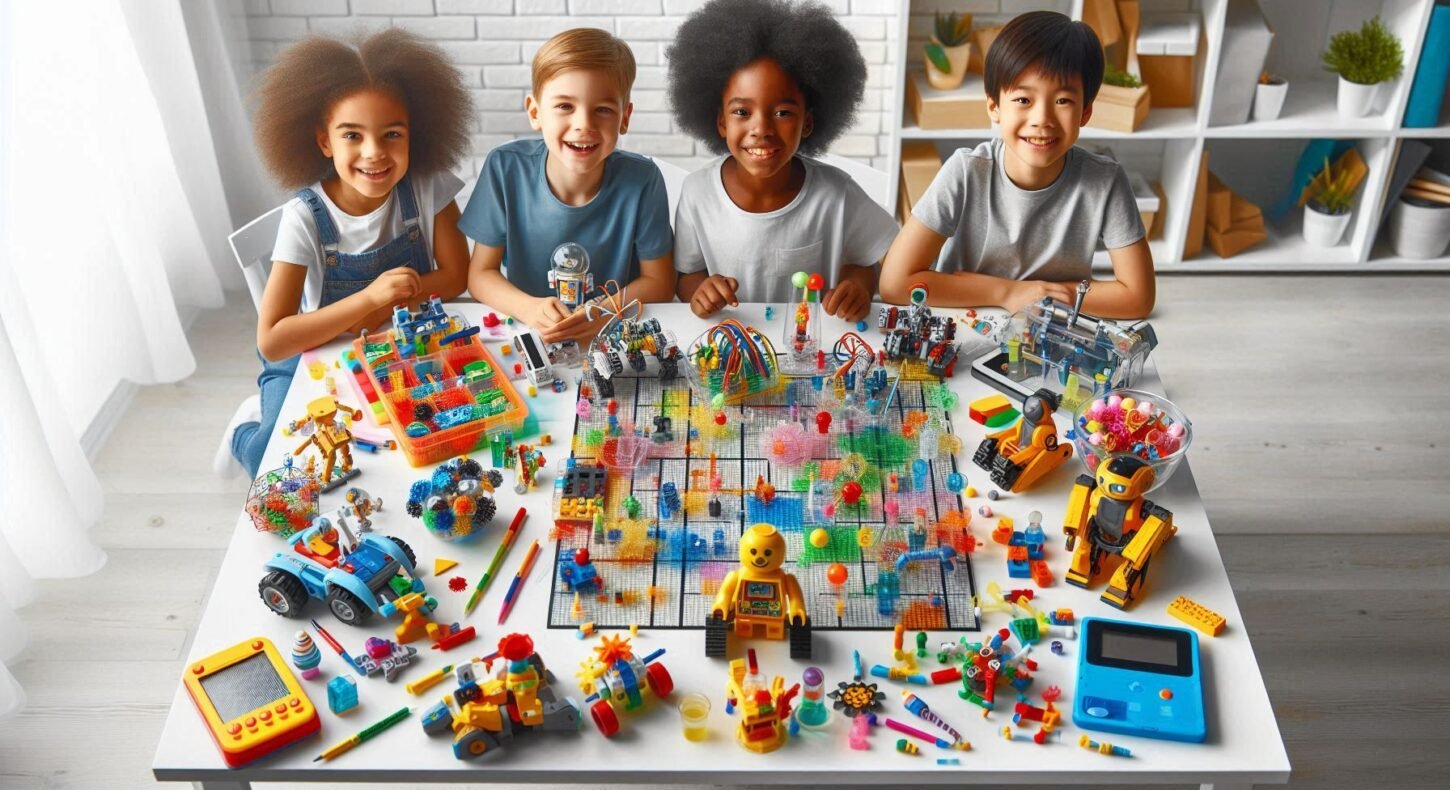What does STEM mean?
Did you know that STEM jobs will make up about 10.5% of all U.S. employment by 2030, according to the Bureau of Labor Statistics? That’s a huge jump from today, with millions of new openings in fields like engineering and tech. Parents often wonder how to get their kids ready for this boom.
STEM toys offer a fun way to build those skills early. They turn play into real learning that boosts critical thinking, problem-solving, and readiness for future jobs. No matter your child’s age, these toys lay a strong base for success.
In this article, we’ll define what STEM toys really are. Then, we’ll look at how they help kids grow at different stages. Finally, you’ll get picks for toys that fit each age group, plus tips on how to join in without taking over.
Defining STEM Toys: More Than Just Building Blocks
STEM toys go way beyond old-school blocks. They mix science, tech, engineering, and math into hands-on fun. Think kits that let kids code a robot or wire a light-up project.
These toys help kids see how ideas connect. A basic one might start with building a bridge from sticks. Then, it adds wires to test if the structure holds power without breaking.
Parents love them because they spark curiosity. Unlike video games that just entertain, STEM toys make kids think and create.
Science, Technology, Engineering, and Math: A Holistic Approach
Good STEM toys blend all four areas at once. Science might show how magnets pull things. Tech could involve a simple app to control lights.
Engineering comes in when kids design and test builds. Math ties it all with measuring lengths or counting parts.
Take a circuit kit like Snap Circuits. Kids snap pieces to make a fan spin. It teaches electricity from science, wiring from engineering, basic counts from math, and even app links from tech. One toy covers it all, making learning feel like play.
Distinguishing Educational Toys from Gimmicks
Not every toy with lights counts as STEM. Look for ones that let kids experiment freely. Does it break if dropped? Is it made to last through rough use?
Check if it matches school standards, like next-gen science goals. True STEM toys push kids to ask why and try fixes, not just follow steps.
Gimmicks shine bright but fade fast. Real educational STEM toys build skills that stick. Ask: Can my child use it in many ways? Does it grow with them?
- Open-ended design: No single right answer.
- Durable materials: Wood or strong plastic.
- Ties to real skills: Like patterns or basic physics.
Spot these, and you’ll pick winners.
Developmental Milestones Achieved Through STEM Play
Play with STEM toys shapes young minds. It hits key growth areas like thinking and hand skills. Kids gain confidence as they solve real puzzles.
Studies show block play boosts space smarts. A report from the American Psychological Association links it to better math scores later. Hands-on work makes abstract ideas click.
From toddlers to tweens, these toys match what kids need at each step.
Cognitive Growth: Logic and Problem Solving (Ages 5-10)
At this age, kids start to grasp order and cause. STEM toys teach step-by-step thinking. They learn to test ideas and fix mistakes.
Building a marble run shows if paths work or not. Does the ball drop right? Why not?
Research backs this up. Kids who play with construction sets score higher on logic tests. It trains the brain to debug, just like coders do.
Logic builds here, setting up school wins and career paths.
Fine Motor Skills and Spatial Reasoning (Toddler to Early Elementary)
Little hands need practice to get steady. STEM toys with small pieces help grip and twist. Think snapping gears or stacking shapes.
This work sharpens control for writing or drawing later. Spatial skills let kids picture how parts fit in 3D.
Try a set of magnetic blocks. Kids build towers and see balance. It challenges them to flip and turn pieces just so.
Over time, this leads to better focus and creativity in daily tasks.
Fostering Resilience and Iterative Design (Ages 8+)
Failure stings, but STEM toys turn it into a win. Kids try, crash, and tweak until it works. This builds grit.
Intro robotics kits often flop at first. A bot might zoom off track. What to change?
It mirrors design thinking: test, learn, repeat. Experts say this mindset helps in any job.
Kids grow tougher and more inventive through these loops.
Age-Specific Recommendations for Maximum Impact
Pick toys that fit your child’s stage. Start simple to avoid frustration. Build up to tougher ones as they grow.
Schools use many of these in class. They prove to engage and teach. Look for sets with guides but room to explore.
Here’s what works best by age.
Early Explorers (Ages 3-5): Introduction to Concepts
Young kids love colors and shapes. Focus on basics like matching or pushing buttons.
Magnetic tiles let them stack wild structures. No mess, just fun snaps.
Large blocks teach stacking and knocking down. It shows gravity in action.
Simple coding boards use arrows to guide a character. Kids learn directions without screens.
These build wonder. Your tot sees patterns emerge from play.
Junior Innovators (Ages 6-9): Building and Programming Basics
Now, add motion and lights. Basic circuits light up as kids connect wires.
LEGO Education kits introduce gears and pulleys. Kids make vehicles that roll true.
Block-based coding like Scratch Jr. lets them program stories. Drag commands to make characters dance.
Robotics starters, such as Sphero Mini, roll on commands. Primary schools swear by them for team work.
These tools spark “aha” moments in mechanics and code.
Emerging Engineers (Ages 10+): Advanced Logic and Real-World Application
Teens crave real challenges. Microcontrollers like Arduino kits let them build sensors.
Raspberry Pi setups control lights or cameras. It’s a step to maker spaces.
K’NEX rods tackle bridges with math on load. Test strength, then improve.
Custom bots connect to phones for apps. It ties to future tech jobs.
These push limits and link play to the world.
The Parent’s Role: Facilitating, Not Directing, STEM Learning
You guide, but let kids lead. Sit back and watch ideas flow. Your job is to nudge, not fix.
Join in chats that spark thought. Share excitement over wins. This keeps play joyful.
Hands-off time lets them own the learning.
Asking Effective, Open-Ended Questions
Good questions dig deeper. They make kids think hard.
Try these:
- What happens if you flip that piece?
- How else could this move faster?
- Why did it fall this time?
- What would make it stronger?
- Can you build it a new way?
These prompts build analysis skills. Kids feel smart when they answer.
Integrating STEM Toys with Real-World Science
Link toys to life for bigger impact. A lever set explains playground swings.
Code a timer? Point to the kitchen clock. It works the same way.
Take a solar kit outside. Show how panels power homes.
Field trips count too. Visit a bridge after building one.
These ties make STEM feel close, not far-off.
Conclusion: Investing in Tomorrow’s Problem Solvers
Play drives the skills kids need now. STEM toys turn free time into growth time.
Choose ones that let trial and error shine. Skip quick builds; go for discovery.
View these as smart buys for your child’s path. They build thinkers who solve big issues. Start today—watch innovation bloom at home.



